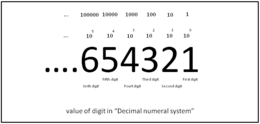
The decimal numeral system (also called the base-ten positional numeral system and denary /ˈdiːnəri/[1] or decanary) is the standard system for denoting integer and non-integer numbers. It is the extension to non-integer numbers (decimal fractions) of the Hindu–Arabic numeral system. The way of denoting numbers in the decimal system is often referred to as decimal notation.[2]
A decimal numeral (also often just decimal or, less correctly, decimal number), refers generally to the notation of a number in the decimal numeral system. Decimals may sometimes be identified by a decimal separator (usually "." or "," as in 25.9703 or 3,1415).[3] Decimal may also refer specifically to the digits after the decimal separator, such as in "3.14 is the approximation of π to two decimals". Zero-digits after a decimal separator serve the purpose of signifying the precision of a value.
The numbers that may be represented in the decimal system are the decimal fractions. That is, fractions of the form a/10n, where a is an integer, and n is a non-negative integer. Decimal fractions also result from the addition of an integer and a fractional part; the resulting sum sometimes is called a fractional number.
Decimals are commonly used to approximate real numbers. By increasing the number of digits after the decimal separator, one can make the approximation errors as small as one wants, when one has a method for computing the new digits.
Originally and in most uses, a decimal has only a finite number of digits after the decimal separator. However, the decimal system has been extended to infinite decimals for representing any real number, by using an infinite sequence of digits after the decimal separator (see decimal representation). In this context, the usual decimals, with a finite number of non-zero digits after the decimal separator, are sometimes called terminating decimals. A repeating decimal is an infinite decimal that, after some place, repeats indefinitely the same sequence of digits (e.g., 5.123144144144144... = 5.123144).[4] An infinite decimal represents a rational number, the quotient of two integers, if and only if it is a repeating decimal or has a finite number of non-zero digits.
- ^ "denary". Oxford English Dictionary (Online ed.). Oxford University Press. (Subscription or participating institution membership required.)
- ^ Yong, Lam Lay; Se, Ang Tian (April 2004). Fleeting Footsteps. World Scientific. 268. doi:10.1142/5425. ISBN 978-981-238-696-0. Archived from the original on April 1, 2023. Retrieved March 17, 2022.
- ^ Weisstein, Eric W. (March 10, 2022). "Decimal Point". Wolfram MathWorld. Archived from the original on March 21, 2022. Retrieved March 17, 2022.
- ^ The vinculum (overline) in 5.123144 indicates that the '144' sequence repeats indefinitely, i.e. 5.123144144144144....